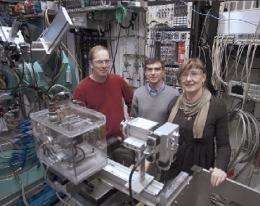An electronic dance of spins and orbits

Because of their potential application in spintronic devices such as next-generation spin-based transistors, the quest for new materials with significant spin-orbit interactions in the electronic ground state is an area of intense research. Since the spin-orbit interaction increases rapidly with atomic number, materials containing heavy elements are natural candidates for this field of inquiry. A novel oxide material containing heavy Iridium atoms displays remarkable properties dominated by spin-orbit interactions in the Iridium 5d valence states according to research carried out at the U.S. Department of Energy’s Advanced Photon Source at Argonne and reported in Physical Review Letters.
The results are all the more unexpected considering that 5d electronic wave functions in iridium have a large spatial extent resulting in strong overlap between neighboring sites and “band” formation which, together with a very strong crystal field from oxygen ions surrounding the Iridium ions, tends to “quench” the orbital angular momentum of 5d electrons and the spin-orbit interaction.
Much as our planet simultaneously spins around its axis and orbits the sun, electrons in atoms have both a spin and an orbital motion around the nucleus. For electrons that feel a strong nuclear potential, these motions are coupled relativistically leading to different energy levels depending on whether the spin and orbital motion are in the same or the opposite direction. This lifting of degeneracy is responsible for fine structure in the absorption/emission spectra of atoms and hence the inclusion of spin-orbit interactions is necessary for a correct description of atomic structure. This weak (relativistic) interaction, however, is rarely important in understanding the behavior of solids. This is because the properties of solids are determined by the outer, valence electrons of constituent atoms, which are usually exposed to much stronger interactions such as crystal fields arising from the overlap with electronic clouds of neighboring atoms, and Coulomb interactions between the electrons in the solid.
But there are special cases where the spin-orbit interaction remains an important player in solids, leading to interesting properties. For example, in rare-earth-based permanent magnets localized 4f electrons giving rise to magnetism are screened from the effects of neighboring electrons in the solid by valence 5d and 6s electrons. Spin-rotational symmetry is broken as a result of spin-orbit coupling, pinning the 4f magnetic moments to certain lattice orientations and resulting in strong permanent magnet behavior. In semiconductors, spin-orbit coupling can be controlled with electric fields allowing tunable spin accumulation, a promising approach towards the development of a spin transistor. Such spintronic devices, which are based on the spin of the electron rather than its charge, promise to deliver enhanced functionality, higher speeds and reduced power consumption.
The researchers in this study, from Argonne National Laboratory, the University of Kentucky, Oak Ridge National Laboratory, and Northern Illinois University, carried out x-ray absorption and magnetic circular dichroism measurements of polycrystalline BaIrO3 at the X-ray Science Division 4-ID-D beamline at the APS to probe the electronic spin and orbital angular momenta, together with their coupling, in the Iridium 5d valence states. They found the presence of a significant orbital angular momentum of 5d electrons, about three times as large as their spin angular momentum, a result of strong spin-orbit coupling in Iridium atoms. The crystals were grown and characterized with macroscopic probes in co-author Gang Cao’s laboratory at the University of Kentucky.
“Finding such atomic-like behavior in a system expected to show itinerant character of valence electrons is exciting,” said Argonne physicist Daniel Haskel, who spearheaded the research. “The spin-orbit coupling is so significant that the atomic-like behavior persists even as applied pressure or chemical doping is used to destroy the magnetic order present in this material.”
“Compared to band-like systems with spin-orbit effects such as GaAs, the more robust, local character of the spin-orbit interaction in third-row transition metal oxides like the weakly-insulating BaIrO3 may prove useful for devices aimed at spin manipulation,” said lead author Maria Angeles Laguna Marco, who came to Argonne on a postdoctoral fellowship from the Spanish government to work with Haskel.
A full understanding of the experimental findings was only possible through theoretical analysis carried out by Michel van Veenendaal, both at Argonne and his home institution, Northern Illinois University. “The beauty here is that, despite the presence of strong crystal field interactions, the relatively weaker spin-orbit and Coulomb interactions end up defining the novel ground state,” van Veenendaal said.
More information: M.A. Laguna-Marco1,et al. “Orbital Magnetism and Spin-Orbit Effects in the Electronic Structure of BaIrO3, Phys. Rev. Lett. 105, 216407 (2010). DOI:10.1103/PhysRevLett.105.216407
Provided by Argonne National Laboratory



















